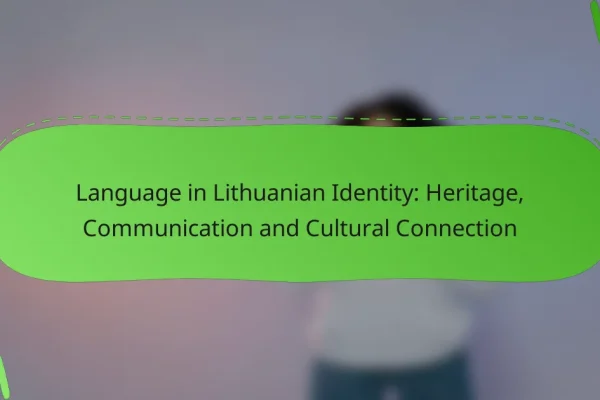How can you experience Lithuania’s cultural heritage?
You can experience Lithuania’s cultural heritage through various engaging activities, including festivals, workshops, tours, and museum visits. Each of these experiences offers a unique insight into the country’s rich traditions and history.
Cultural festivals in Vilnius
Vilnius hosts numerous cultural festivals throughout the year, showcasing music, dance, and traditional crafts. Events like the Vilnius Festival and the International Street Music Day attract both locals and tourists, providing a vibrant atmosphere filled with performances and local cuisine.
Attending these festivals allows you to immerse yourself in Lithuanian culture, meet artisans, and enjoy traditional foods such as cepelinai (potato dumplings) and šakotis (tree cake). Check the festival calendar ahead of time to plan your visit around these lively events.
Traditional crafts workshops in Kaunas
Kaunas offers traditional crafts workshops where visitors can learn skills such as weaving, pottery, and wood carving. These hands-on experiences are typically led by local artisans who share their knowledge and techniques, allowing participants to create their own unique pieces.
Workshops are often available for all skill levels and can be booked in advance. Engaging in these activities not only supports local craftspeople but also provides a deeper understanding of Lithuania’s artistic heritage.
Historical tours in Trakai
Trakai, known for its picturesque castle, offers historical tours that delve into Lithuania’s medieval past. Guided tours often include visits to the island castle, where you can learn about the Grand Duchy of Lithuania and its significance in European history.
Consider joining a walking tour or a boat tour around the lakes to enhance your experience. These tours typically last a few hours and can be a great way to appreciate the stunning scenery while gaining insights into the region’s heritage.
Museum visits in Klaipėda
Klaipėda is home to several museums that highlight Lithuania’s maritime history and cultural evolution. The Maritime Museum and the History Museum of Lithuania Minor are must-visit locations that offer exhibitions on local traditions, artifacts, and historical events.
Plan your visit to coincide with special exhibitions or events for a richer experience. Many museums offer guided tours, which can provide valuable context and enhance your understanding of the displays.
What are the key elements of Lithuania’s cultural heritage?
Lithuania’s cultural heritage is characterized by its rich folklore, unique architectural landmarks, diverse local cuisine, and vibrant art and literature. These elements reflect the country’s history, traditions, and the influences of various cultures over time.
Folklore and traditional music
Lithuanian folklore is deeply rooted in the country’s history, featuring a wealth of myths, legends, and folk tales that convey moral lessons and cultural values. Traditional music, often accompanied by unique instruments like the kanklės, plays a vital role in celebrations and rituals, showcasing the community’s spirit.
Festivals such as Užgavėnės, which marks the end of winter, highlight the importance of folklore through music, dance, and costumes. Engaging with these traditions can provide insight into Lithuania’s identity and communal bonds.
Architectural landmarks
Lithuania boasts a variety of architectural styles, from Gothic and Renaissance to Baroque and Neoclassical. Notable landmarks include Vilnius Old Town, a UNESCO World Heritage site, and the stunning Trakai Island Castle, which reflects the country’s medieval history.
Exploring these sites offers a glimpse into Lithuania’s past and its architectural evolution. Many buildings are adorned with intricate details and serve as cultural hubs, hosting events and exhibitions that celebrate Lithuanian heritage.
Local cuisine
Lithuanian cuisine is hearty and diverse, featuring ingredients like potatoes, rye, and dairy. Traditional dishes such as cepelinai (potato dumplings) and šaltibarščiai (cold beet soup) are staples that showcase the country’s agricultural roots.
Food plays a central role in Lithuanian culture, often enjoyed during family gatherings and festivals. Sampling local cuisine provides a delicious way to connect with the nation’s traditions and flavors.
Art and literature
The art scene in Lithuania is vibrant, with influences from both local and international movements. Traditional crafts, such as weaving and pottery, coexist with contemporary art forms, reflecting the country’s dynamic cultural landscape.
Lithuanian literature has a rich history, with notable authors like Kristijonas Donelaitis and modern poets contributing to the national narrative. Engaging with Lithuanian literature can deepen understanding of the country’s cultural identity and historical context.
What are the benefits of preserving cultural heritage in Lithuania?
Preserving cultural heritage in Lithuania offers numerous benefits, including economic growth through tourism, a strengthened national identity, and increased community involvement. These advantages contribute to the overall well-being and cohesion of society.
Boosting tourism
Cultural heritage sites in Lithuania, such as Vilnius Old Town and the Curonian Spit, attract millions of visitors each year. By preserving these sites, Lithuania can enhance its appeal as a travel destination, leading to increased revenue from tourism-related activities.
Investing in heritage preservation can create jobs in sectors like hospitality, guiding, and local crafts. This not only supports the economy but also encourages sustainable tourism practices that benefit local communities.
Enhancing national identity
Preserving cultural heritage fosters a sense of pride and belonging among Lithuanians. It reinforces the unique aspects of Lithuanian culture, such as traditional music, dance, and crafts, which are vital for maintaining a distinct national identity.
Engaging with cultural heritage helps citizens connect with their history and traditions, promoting unity and resilience in the face of globalization. Celebrating local customs and festivals can further strengthen this bond among communities.
Promoting community engagement
Involving local communities in cultural heritage preservation encourages active participation and collaboration. This can take the form of workshops, volunteer programs, or educational initiatives that empower individuals to take ownership of their cultural assets.
Community engagement not only enhances the preservation efforts but also fosters social cohesion. By working together on heritage projects, residents can build relationships and strengthen their ties to one another and their shared history.
How does Lithuania’s cultural heritage compare to other Baltic states?
Lithuania’s cultural heritage is distinct yet shares common threads with its Baltic neighbors, Latvia and Estonia. While all three countries have rich traditions influenced by their history and geography, Lithuania’s heritage is characterized by its unique language, folk customs, and historical narratives.
Similarities with Latvia’s traditions
Lithuania and Latvia exhibit several similarities in their cultural practices, particularly in folk music and dance. Both nations celebrate traditional festivals that highlight their agrarian roots, such as Jāņi in Latvia and Rasos in Lithuania, which mark the summer solstice.
Additionally, both countries have a strong emphasis on craftsmanship, particularly in textiles and woodwork. The use of intricate patterns in traditional clothing and handicrafts reflects shared historical influences and regional aesthetics.
Differences from Estonia’s heritage
While Lithuania and Estonia share a Baltic identity, their cultural heritages diverge significantly. Estonia’s heritage is heavily influenced by Finnish and Scandinavian traditions, evident in its language and folk tales, which differ from Lithuania’s Slavic roots and distinct language.
Moreover, Estonia places a greater emphasis on modern digital culture and innovation, whereas Lithuania often focuses on preserving and promoting its historical customs and folklore. This difference can be seen in the types of festivals celebrated, with Estonia hosting events that celebrate technology alongside traditional arts.
What are the challenges in preserving Lithuania’s cultural heritage?
Preserving Lithuania’s cultural heritage faces several significant challenges, including urbanization, funding issues, and the transfer of knowledge across generations. These factors can threaten the integrity and continuity of cultural practices, historical sites, and traditional crafts.
Urbanization impacts
Urbanization in Lithuania has led to the rapid development of cities, often at the expense of historical sites and traditional neighborhoods. As new infrastructure replaces older buildings, unique cultural landmarks may be lost, diminishing the sense of place and identity.
Efforts to balance urban growth with heritage preservation require careful planning and community involvement. Local governments can implement regulations to protect significant sites and promote adaptive reuse of buildings, ensuring that urban development does not erase cultural history.
Funding and resource allocation
Limited funding for cultural heritage projects poses a major challenge in Lithuania. Many preservation initiatives rely on government support, which can be inconsistent and insufficient to cover the necessary costs of restoration and maintenance.
To address funding issues, partnerships between public and private sectors can be beneficial. Encouraging local businesses and international organizations to invest in heritage projects can create sustainable funding sources and foster community engagement.
Generational knowledge transfer
The transfer of knowledge regarding traditional crafts and cultural practices is crucial for preserving Lithuania’s heritage. However, as younger generations move away from rural areas and modernize their lifestyles, there is a risk of losing these valuable skills.
To combat this, initiatives such as workshops, mentorship programs, and cultural festivals can help engage youth and encourage them to learn and appreciate their heritage. Schools can also incorporate local history and traditions into their curricula to foster a sense of pride and continuity among students.






